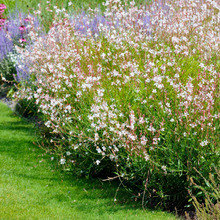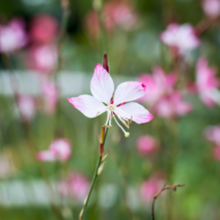Gaura lindheimeri, often known as Lindheimer's gaura, is a delicate perennial noted for its butterfly-like flowers and prolonged blooming. This plant features slender, upright stems with pointed leaves, and produces a continuous display of small, white or pink flowers from late spring until autumn. Its open, branching form and extended flowering period make it a valuable addition to gardens, borders, and natural-looking plantings, contributing an airy and graceful presence to various settings. It is part of the Onagraceae family.
Origin: Gaura lindheimeri originates from the southern United States, specifically Texas and Louisiana.
Light: Gaura lindheimeri performs best in full sunlight. It requires at least six hours of direct sunlight each day for optimal flowering and growth.
Water: Water regularly during the first growing season to help establish a strong root system. Once established, it demonstrates some tolerance to dry conditions. Allow the soil to dry slightly between waterings to prevent root rot.
Soil: Gaura lindheimeri prefers soil that drains well. It can adapt to a range of soil types, including sandy, loamy, and rocky soils, as long as they drain properly. Avoid heavy clay soils, which retain excessive moisture.
Fertilising: This plant generally does not require heavy feeding. A light application of a balanced fertiliser in spring can promote healthy growth. Avoid over-fertilising, which can lead to excessive leaf growth at the expense of flower production.
Pruning: Cut back the plant in late autumn or early spring to tidy it up and encourage new growth. Removing spent flowers can prolong the blooming period.
Self-seeding: Gaura lindheimeri spreads readily through self-seeding, so new plants may appear in the garden.
Pests and Diseases: Gaura lindheimeri is generally resistant to pests and diseases, but watch out for aphids and powdery mildew.
Uses: Gaura lindheimeri is primarily cultivated for its attractive flowers and airy structure. It is a popular choice for gardens, borders, and natural-looking plantings. It also attracts bees and butterflies.
Toxicity: Gaura lindheimeri is generally considered safe for humans and pets.



